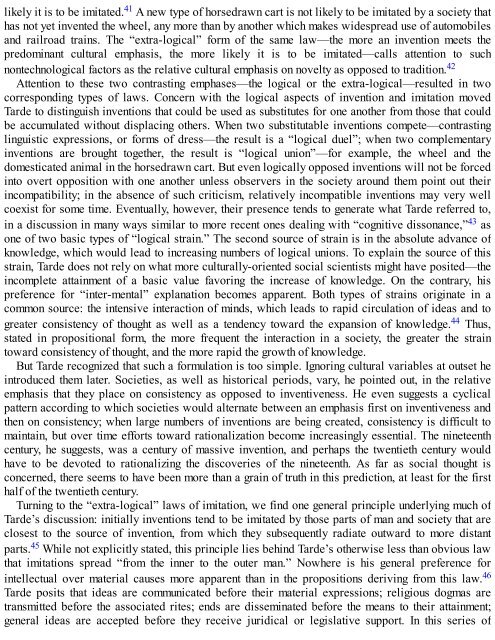3658925934
Create successful ePaper yourself
Turn your PDF publications into a flip-book with our unique Google optimized e-Paper software.
likely it is to be imitated. 41 A new type of horsedrawn cart is not likely to be imitated by a society that<br />
has not yet invented the wheel, any more than by another which makes widespread use of automobiles<br />
and railroad trains. The “extra-logical” form of the same law—the more an invention meets the<br />
predominant cultural emphasis, the more likely it is to be imitated—calls attention to such<br />
nontechnological factors as the relative cultural emphasis on novelty as opposed to tradition. 42<br />
Attention to these two contrasting emphases—the logical or the extra-logical—resulted in two<br />
corresponding types of laws. Concern with the logical aspects of invention and imitation moved<br />
Tarde to distinguish inventions that could be used as substitutes for one another from those that could<br />
be accumulated without displacing others. When two substitutable inventions compete—contrasting<br />
linguistic expressions, or forms of dress—the result is a “logical duel”; when two complementary<br />
inventions are brought together, the result is “logical union”—for example, the wheel and the<br />
domesticated animal in the horsedrawn cart. But even logically opposed inventions will not be forced<br />
into overt opposition with one another unless observers in the society around them point out their<br />
incompatibility; in the absence of such criticism, relatively incompatible inventions may very well<br />
coexist for some time. Eventually, however, their presence tends to generate what Tarde referred to,<br />
in a discussion in many ways similar to more recent ones dealing with “cognitive dissonance,” 43 as<br />
one of two basic types of “logical strain.” The second source of strain is in the absolute advance of<br />
knowledge, which would lead to increasing numbers of logical unions. To explain the source of this<br />
strain, Tarde does not rely on what more culturally-oriented social scientists might have posited—the<br />
incomplete attainment of a basic value favoring the increase of knowledge. On the contrary, his<br />
preference for “inter-mental” explanation becomes apparent. Both types of strains originate in a<br />
common source: the intensive interaction of minds, which leads to rapid circulation of ideas and to<br />
greater consistency of thought as well as a tendency toward the expansion of knowledge. 44 Thus,<br />
stated in propositional form, the more frequent the interaction in a society, the greater the strain<br />
toward consistency of thought, and the more rapid the growth of knowledge.<br />
But Tarde recognized that such a formulation is too simple. Ignoring cultural variables at outset he<br />
introduced them later. Societies, as well as historical periods, vary, he pointed out, in the relative<br />
emphasis that they place on consistency as opposed to inventiveness. He even suggests a cyclical<br />
pattern according to which societies would alternate between an emphasis first on inventiveness and<br />
then on consistency; when large numbers of inventions are being created, consistency is difficult to<br />
maintain, but over time efforts toward rationalization become increasingly essential. The nineteenth<br />
century, he suggests, was a century of massive invention, and perhaps the twentieth century would<br />
have to be devoted to rationalizing the discoveries of the nineteenth. As far as social thought is<br />
concerned, there seems to have been more than a grain of truth in this prediction, at least for the first<br />
half of the twentieth century.<br />
Turning to the “extra-logical” laws of imitation, we find one general principle underlying much of<br />
Tarde’s discussion: initially inventions tend to be imitated by those parts of man and society that are<br />
closest to the source of invention, from which they subsequently radiate outward to more distant<br />
parts. 45 While not explicitly stated, this principle lies behind Tarde’s otherwise less than obvious law<br />
that imitations spread “from the inner to the outer man.” Nowhere is his general preference for<br />
intellectual over material causes more apparent than in the propositions deriving from this law. 46<br />
Tarde posits that ideas are communicated before their material expressions; religious dogmas are<br />
transmitted before the associated rites; ends are disseminated before the means to their attainment;<br />
general ideas are accepted before they receive juridical or legislative support. In this series of









![Genki - An Integrated Course in Elementary Japanese II [Second Edition] (2011), WITH PDF BOOKMARKS!](https://img.yumpu.com/58322134/1/180x260/genki-an-integrated-course-in-elementary-japanese-ii-second-edition-2011-with-pdf-bookmarks.jpg?quality=85)
![Genki - An Integrated Course in Elementary Japanese I [Second Edition] (2011), WITH PDF BOOKMARKS!](https://img.yumpu.com/58322120/1/182x260/genki-an-integrated-course-in-elementary-japanese-i-second-edition-2011-with-pdf-bookmarks.jpg?quality=85)





